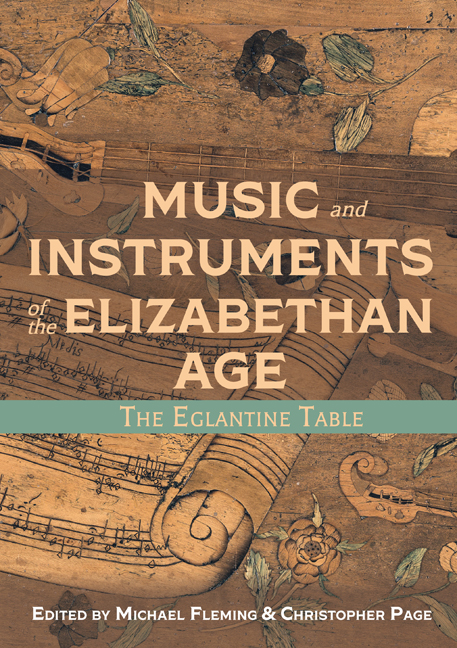Book contents
- Frontmatter
- Dedication
- Contents
- List of Illustrations
- Foreword
- Acknowledgements
- Note to the Reader
- List of Abbreviations
- Introducing the Eglantine Table
- Part I Silent Things
- Part II Music and Instruments
- Part III Broader Views of the Eglantine Table
- Appendices
- Glossary
- Bibliography
- List of Contributors
- Index
- Plate section
7 - ‘A full and lively pourtraiture’: The Table as Evidence for Tudor Musical Instruments
Published online by Cambridge University Press: 24 March 2021
- Frontmatter
- Dedication
- Contents
- List of Illustrations
- Foreword
- Acknowledgements
- Note to the Reader
- List of Abbreviations
- Introducing the Eglantine Table
- Part I Silent Things
- Part II Music and Instruments
- Part III Broader Views of the Eglantine Table
- Appendices
- Glossary
- Bibliography
- List of Contributors
- Index
- Plate section
Summary
Even if depictions of musical instruments in Elizabethan art were plentiful, the Eglantine Table would count as a major source of information about the appearance and fashioning of the kinds that were played during the queen's reign. Yet such representations are, in fact, very rare. Depictions such as the scene with violinists in Marcus Gheeraerts the Elder's painting commonly known as A Fetê at Bermondsey, the broken consort and the viol consort in the portrait of Sir Henry Unton, and the citterns and bandoras carved on the staircase of Lord Burghley's house at Theobalds, now at Herstmonceux Castle, are all the more precious for being exceptional. The consequences may be imagined. Despite A Fête at Bermondsey and a handful of other examples, sixteenth-century English depictions of bowed instruments, for example, are too rare to provide a canon that might establish whether those shown on the Eglantine Table should be regarded as typical or extraordinary.
The contributors to this book must often reach for continental examples to find a comparator or illuminate a point. Without such comparators, and even with them, it is often hard to establish the relation between a representation of an instrument in an English source of the sixteenth century – the Eglantine Table or any other – and the object to which the picture alludes. Consequently, it is difficult to distinguish what may be typical from what may be anomalous, or even to verify the currency of anything answering in more than a general way to what is shown. Features or combinations of features that appear only in one depiction may be erroneous or idiosyncratic, but may also indicate something otherwise undocumented, while the absence of a feature or even a type of instrument from the pictorial record does not prove that it was unknown or even rare.
If the English material is sparse relative to what may be found abroad, it is not simply because ‘the Continent’ in this context means a riven Western Christendom extending from at least Atlantic France to Hungary. It is also, in the first instance, because a great deal of native work has been lost.
- Type
- Chapter
- Information
- Music and Instruments of the Elizabethan AgeThe Eglantine Table, pp. 113 - 124Publisher: Boydell & BrewerPrint publication year: 2021

